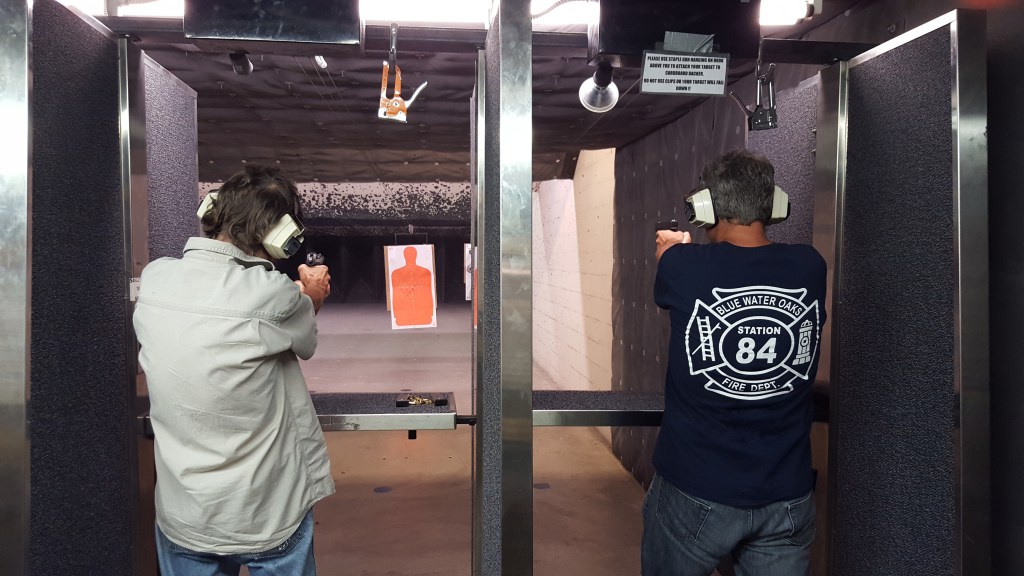When we shoot guns, we prioritize our safety above anything else, but one factor is being routinely ignored: lead dust exposure from the firing of rounds.
Most bullets are constructed using a solid lead core which is encased in a copper jacket that used gunpowder and a lead primer to cause the explosion and propulsion. When you pull the trigger, this lead primer ignites, causing some of the lead on the bullet to boil.
The bullet shoots out of the end of the barrel, followed by a spray of lead particles from the primer. The casing jumps out of the ejection port, very close to where your face is located, with lead particles from the core and primer trailing it.
Both of these ejections lead to a significant amount of lead dust to exit the weapon, a problem that is unlikely to be harmful outdoors but could be potentially lethal in an inside range.
If the indoor range doesn’t re-filter the air correctly, this lead dust will collect on your clothing and can be inhaled directly from the air. Obviously, the longer you spend in these ranges, the more significant the hazard, hence those most severely impacted are weapons instructors, police and military personnel who shoot regularly.
A 1-Year-Old Boy in Connecticut Experienced Lead Poisoning from Firearms
A 1-year-old boy in Connecticut was found to have blood lead levels that far exceeded the expected standards. This exposure to lead was found to come from his father’s clothes because he worked as a maintenance worker at an indoor shooting range. The lead stuck to his apparel and when he touched his son in the evening, it would spread the harm.
The Department of Defense recently lowered its level for acceptable lead dilution to 20 micrograms of lead per deciliter of blood. This new policy came about because of a National Academy of Sciences report in 2012 which showed that defense personnel was at significant risk of lead poisoning from shooting firearms.
The Occupational Safety and Health Administration guidelines have a much higher acceptable level, and this study explained that those following the OSHA standard could expect adverse health consequences.
Their level hasn’t been updated since 1970, and many professionals have called for improvements since because they believe it to be dangerously outdated. Over 1 million law enforcement officers use indoor ranges, with an estimated 17,000 private indoor ranges across the country.
The OSHA standards decree that employees cannot surpass 60 micrograms of lead per deciliter of blood. But adverse effects on employee’s brain function, kidney function, and cardiovascular health has been detected after levels as low as five micrograms of lead per deciliter of blood.
Many of the health effects of lead can be incredibly subtle or nonspecific, causing people to continue to expose themselves repeatedly without recognizing the association. Mark Laidlaw, an environmental health scientist said that “memory and concentration problems, headache, abdominal pain” can all be caused by lead exposure.
Victims Often Don’t Associate Their Problems with Guns
“You can have one of these health effects, but the shooters might not realize these are associated with their shooting. They just don’t know they’re lead poisoned” he said.
According to the CDC, at levels higher than five micrograms of lead per deciliter of blood, people might experience kidney dysfunction or even spontaneous abortions. But as these levels rise the health problems are likely to become more severe and frequent.
The research from two newspaper investigations suggests that the high levels of lead found in law enforcement facilities and firing ranges are most likely because of failing ventilation. For this reason, it’s vital that all indoor shooting ranges use adequate ventilation and maintain it regularly.
Laidlaw believes that even the new defense department’s blood lead limit of 20 doesn’t go far enough to address the problem at hand. Instead, he thinks that a maximum of 10 micrograms would be a better standard, with the ultimate solution being to eliminate the use of lead from bullets and primers entirely.
“I worry about the health of the young men and women in the military who are exposed to lead regularly while using firearms,” he said.


